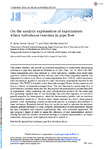On the analytic explanation of experiments where turbulence vanishes in pipe flow

Use este enlace para citar
http://hdl.handle.net/2183/32205Coleccións
- GI-SISTER - Artigos [35]
Metadatos
Mostrar o rexistro completo do ítemTítulo
On the analytic explanation of experiments where turbulence vanishes in pipe flowData
2022-11-02Cita bibliográfica
Javier García García, F., & Fariñas Alvariño, P. (2022). On the analytic explanation of experiments where turbulence vanishes in pipe flow. Journal of Fluid Mechanics, 951, A4. doi:10.1017/jfm.2022.651
Resumo
[Abstract]: The present research will provide an analytical explanation to experiments destabilising turbulence in pipe flow reported in Kuehnen et al. (Nat. Phys., vol. 14, 2018, 386–390). Those experiments show four methods by which turbulence vanishes from steady-state
pipe flow, without decreasing its bulk velocity, until it becomes completely laminar. The
explanation is based on our theory of underlying laminar flow (TULF), which has already
been successfully applied to account for other uncommon experiments reported in the
literature. The TULF is founded on the Reynolds-averaged Navier–Stokes equations and
thus is a theory of ensemble-averaged flows. The zero theorem for steady-state flow is
introduced as a universal result that will help explain the laminarisation process described
in experiments. After presenting the most comprehensive solution for the mean pipe
flow governing equation that, to our knowledge, has ever been reported, we uncover a
general sequence for laminarisation, called the laminarisation pattern, and we introduce
a mathematical model for it. We show that a drastic decrease in a flow’s mean-pressure
gradient, while maintaining constant its Reynolds number, is necessary and sufficient to
erase turbulence. Equations derived from our model are used to calculate the minimum
pressure gradient necessary to cause complete laminarisation in each experiment. Results
are then contrasted with reported experimental data, with noticeable agreement. We
also propose a figure of merit to assess the efficiency of each laminarisation method.
Having disclosed the intrinsic mechanism leading to complete laminarisation, we expect
researchers will propose other ingenious methods to achieve it.
Palabras chave
General fluid mechanics
Pipe Flow
Turbulence theory
Pipe Flow
Turbulence theory
Versión do editor
Dereitos
Attribution 4.0 International
ISSN
1469-7645





